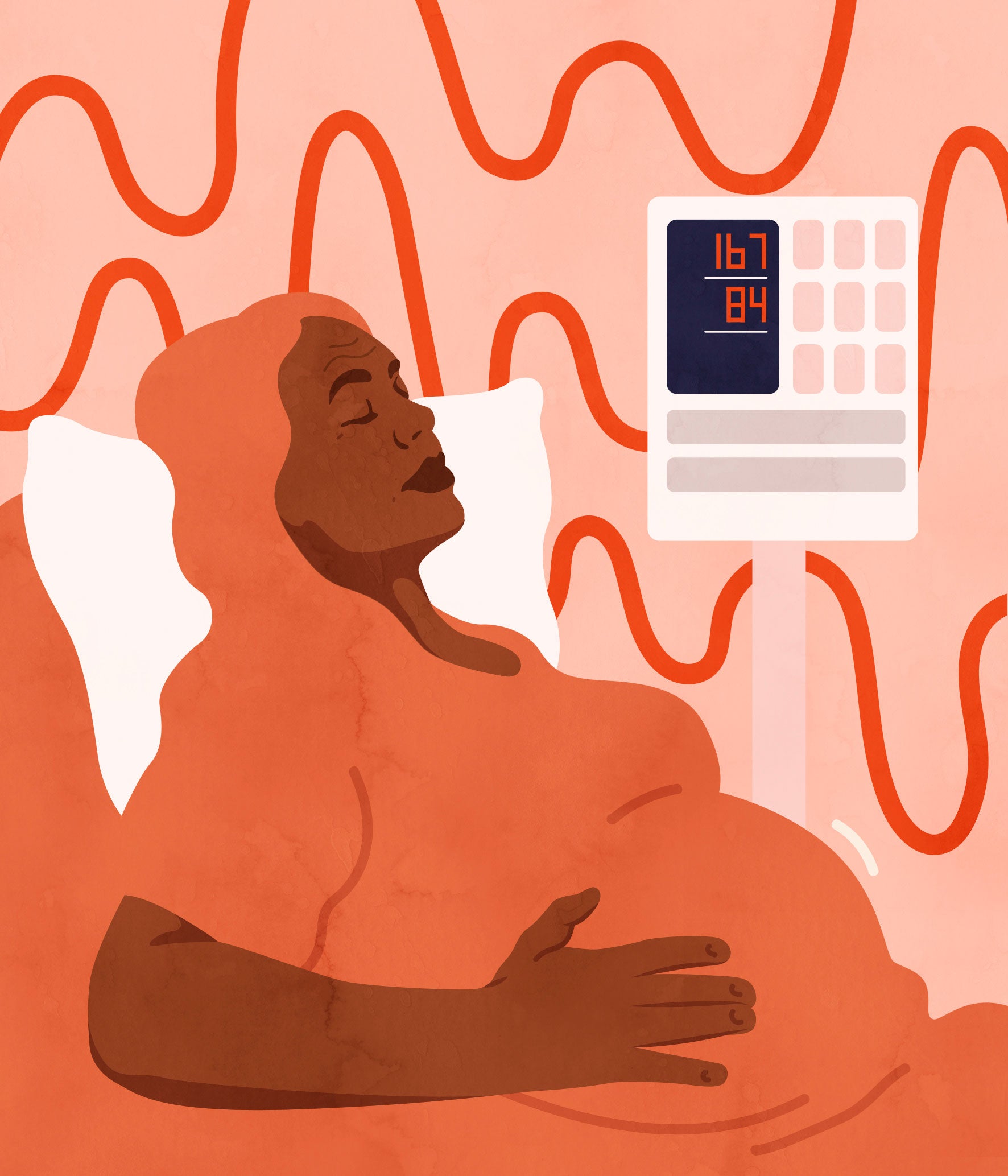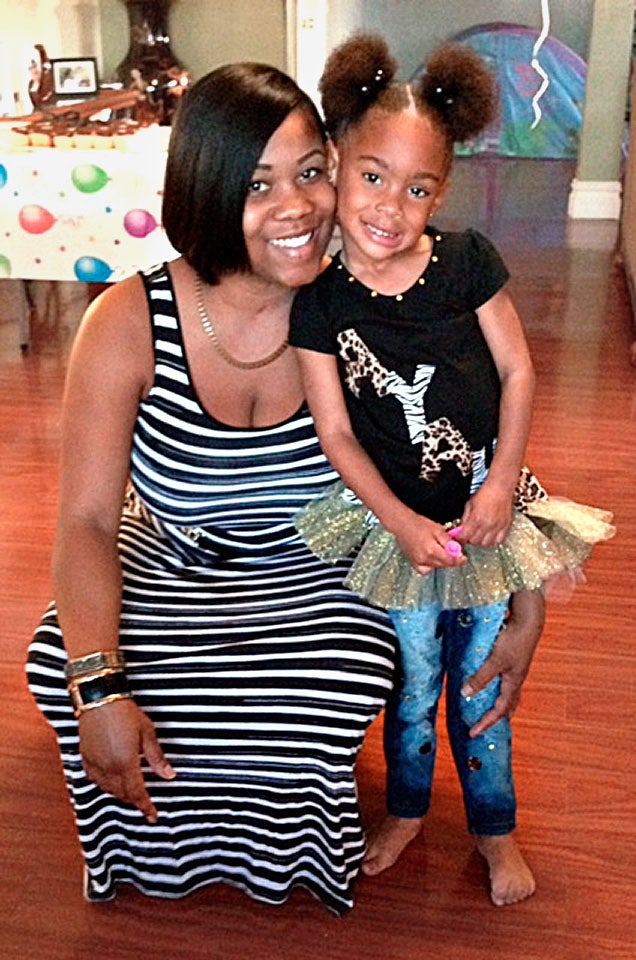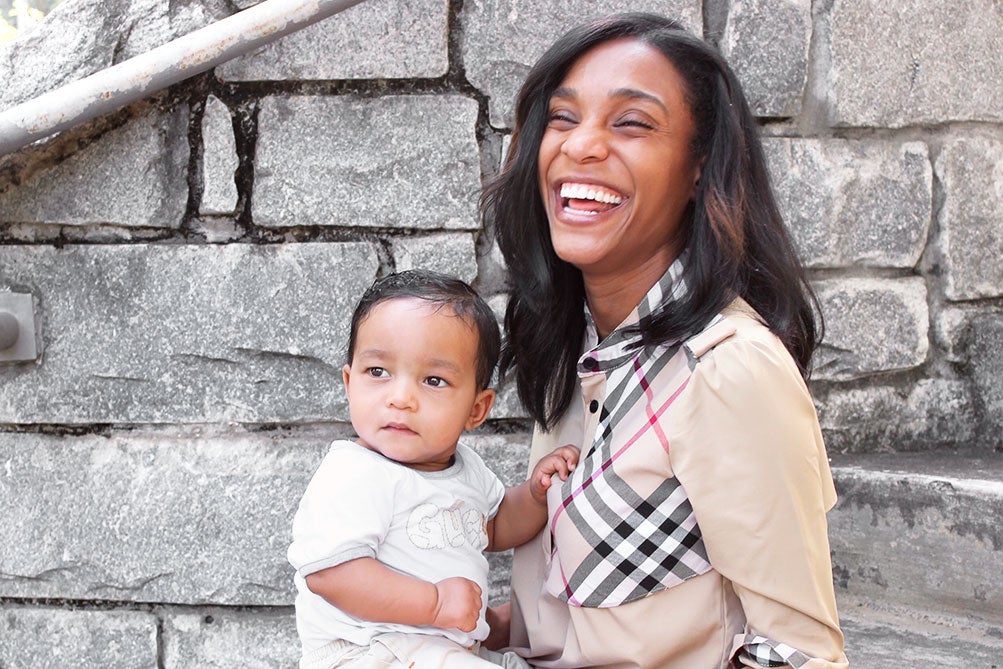A Matter Of Life & Death: Why Are Black Women In The U.S. More Likely To Die During Or After Childbirth?
Late at night on February 4, 2010, when she was 37 weeks pregnant, Fathiyyah “Tia” Doster started feeling bloated. She assumed it was from the food she’d eaten for dinner. “I didn’t think it was an emergency at all. That never crossed my mind,” she says. Then age 25 and working as an addiction counselor in Tampa, she’d breezed through her pregnancy thus far without even morning sickness, only needing iron pills for anemia, as she had for years. Tia planned on a water birth at a midwifery practice.
When her discomfort did not dissipate, Tia called her midwife, who also blamed the late-night dinner, but added, “If it makes you feel better, come in and we’ll check you out.” It was already after midnight when Tia called a friend, who drove her the 30 minutes to the hospital where the midwife was on call. While growing up in a nurturing family, Tia had been steeped in the importance of preventive care. “It’s about being able to listen to your body and be proactive about whatever is going on, and not just waiting until things get really, really bad,” she explains. She just wanted to be sure that she wasn’t in labor.
At the hospital a nurse took Tia’s vitals. Suddenly the nurse seemed nervous. Tia’s blood pressure was extremely high. The nurse said she might need to have an emergency C-section and went to alert the doctors. Tia remembers seeing the nurse’s back in the doorway. “I was trying to say, “Come back,”” she says. Then her body stiffened and everything went blurry. When she awoke, she was in an ICU bed, covered in tubes, disoriented. Her daughter had been delivered while she was unconscious. Tia was not stable enough for the baby to be brought to her. The dramatic spike in her blood pressure had caused seizures that led to multiorgan failure. She was diagnosed with HELLP Syndrome, a life-threatening liver condition. “Everybody was in a state of shock” over how quickly the crisis had set in, Tia says. “It’s hard to fathom.” She was hospitalized for more than three months.
During much of her hospital stay, Tia was unable to hold her daughter, Ayah. “Emotionally, it was just a really hard time,” she says. The baby was cared for by the father and Tia’s mother. Though Tia had a steady stream of visitors, nothing could make up for missing her daughter’s birth and early babyhood. “I didn’t really get a chance to bond with her,” she says. “For a very long time, I felt this detachment.”
CAUSE FOR ALARM
While Tia’s experience might seem like a nightmare, so much went well: She trusted her observations about her body. She asked questions. The midwife invited her to come to the hospital. Tia asked for help. Her friend offered to make the late-night drive. The nurse responded promptly to a warning sign. The hospital’s medical team reacted immediately and precisely. Had anyone in that chain acted differently, Tia and her daughter might not have lived. She considers her remaining nerve damage and scars “a reminder to be grateful.”
Increasingly, however, and at startling rates, hundreds of Black women in the U.S. are losing their lives during pregnancy, childbirth and the postpartum period. They are between three and four times more likely to die of a pregnancy-related complication than White women. Black women are also twice as likely to suffer a problem so severe that they almost die, referred to as a near miss. The racial disparity transcends education and income levels, unraveling common assumptions about who suffers in our health care system. “I don’t want to sound an alarm that every Black woman who gets pregnant should be like, “Oh, my God, I’m going to die.” Because that isn’t the case,” says Haywood L. Brown, M.D., president of the American College of Obstetricians and Gynecologists. “We just want people to know that “I might be at a little higher risk because I’m a woman of color, regardless of what side of the track I’m on.”” No single explanation captures why. “There are many factors,” Brown adds. The complex web of causes—which includes genetic predispositions, chronic stress, racial bias and structural barriers to health care—contributes to the racial disparity in maternal health. Each time a Black woman dies of pregnancy-related issues, a different combination of some or all of those factors has coalesced.
A FATEFUL CHAIN OF EVENTS
By age 37 Kyira “Kira” Dixon Johnson had pulled off feats that most people can only imagine: After graduating college she’d started businesses, learned to pilot airplanes and skydive solo, raced cars and ran marathons. She spoke five languages. For four years she had lived in China, where she opened language schools. Kira had always wanted kids, but was waiting for the right person to have them with. That person turned out to be Charles Johnson IV—whom she’d dated before moving to China and had reconnected with after returning home to Atlanta. Both were entrepreneurs, and Charles loved trading ideas with Kira. She made his world feel expansive, loaded with possibilities. He remembers flipping through not one but two of her passports so covered in stamps that they needed extra pages. “The way she approached life was unlike anybody I’d ever met before,” Charles says. She had an inborn warmth and generosity, but, “if there was something that needed to get done, it would get done.”

PETRA ERIKKSON
When Kira became pregnant in 2014, she and Charles promised each other that the baby wasn’t going to slow them down. “We’d been tremendously blessed,” says Charles, whose mother is the Honorable Glenda Hatchett of the TV series The Verdict With Judge Hatchett. Kira was relatively old for a first-time mom, but she was fit and “exceptionally healthy,” Charles says. In September 2014 their son Charles was born without complications. “She was beside herself,” Hatchett says. “She was so happy.” Kira threw herself into caring for little Charles, just as she’d done for everything else she’d ever wanted. And true to their promise, Charles and Kira traveled with the baby—to France, Monaco and Colombia.
In 2015, the couple married and Kira became pregnant again. She was ecstatic to be having another boy. While she was expecting, the Johnsons moved to California to pursue business opportunities. On April, 12, 2016, Kira was scheduled for a caesarean at Cedars-Sinai, a top-ranked research hospital in Los Angeles where Beyoncé gave birth to twins this past June. At 2:33 P.M., Langston Johnson was born. A half hour later Kira was holding her healthy baby.
That was the calm before the storm. Just before 5 P.M., Charles, who had remained at Kira’s bedside, noticed that the fluid in her Foley catheter—the thin tube inserted in patients to drain urine—was tinged red. Twenty minutes later, the “Foley catheter was draining bright red blood,” according to the legal complaint the family later filed against the hospital. The complaint stated that after that catheter was replaced, blood ran through the next one, too. An ultrasound showed fluid might be collecting in Kira’s abdomen, and she was given medication for pain. At 6:44 P.M., a physician reportedly ordered a “stat” scan of Kira’s abdomen and pelvis because of “surgical emergency.” Kira’s medical records later showed no evidence that the scan was ever done, says the family.
Over the next few hours, an abdominal ultrasound showed a blood clot, the replacement catheter continued to drain blood, Kira received fluids and blood transfusions and felt “intractable abdominal pain,” according to the complaint. But the physician who had delivered Langston and was overseeing Kira’s care didn’t return to her bedside until 8:47 P.M. At 10:55 P.M., a nurse reportedly notified the doctors that Kira’s blood pressure had plummeted. Charles says that as Kira became paler and groggier, she asked him not to tell her own mother, in town for the birth, so she wouldn’t worry. He says he continued to ask medical staffers why they still hadn’t taken action to determine why she was bleeding. At 11:25 P.M., the complaint states, the overseeing physician was notified about potential “active internal bleeding.” At 11:42 P.M., after an ultrasound showed an expanding blood clot and fluid that shouldn’t have been there, two attending physicians recommended taking Kira to surgery so they could investigate, the complaint says. The lead physician allegedly decided against surgery. Almost an hour later, when Kira was taken to surgery, physicians reportedly found three liters of blood in her abdomen. She’d been hemorrhaging. Around 2 A.M., Charles called his mother and asked her to pray. At 2:22 A.M. on April 13, 2016, Kira was pronounced dead of hemorrhagic shock—she had bled to death.
CHILDBIRTH IN CRISIS

COURTESY OF SUBJECT
Pregnancy-related deaths are relatively rare. Yet America has some of the worst maternal health outcomes in the world: Every year about 700 women, representing all races and stations in life, die of pregnancy-related causes. Roughly 65,000 women experience a near miss. The United States is the only industrialized nation where the maternal mortality rate is on the rise. Some of the reasons for the increase in the overall maternal death rate cross racial lines. Unlike those of previous generations, new moms are older today—which means they could be more likely to have more preexisting conditions, like diabetes or hypertension, that raise the chance of problems. More American women are overweight or obese, another risk factor. But all women over the age of 35, like Kira—and especially Black women at this stage—are at higher risk of childbirth complications, regardless of their prepregnancy health.
The disproportionate number of Black women who die largely accounts for the United States’ high maternal death rate. In some rural counties and dense cities alike, the racial disparity in maternal deaths is jaw-dropping: Chickasaw County, Mississippi, for instance, has a maternal death rate for women of color that’s higher than Rwanda’s. In New York City, Black women are 12 times more likely than White women to die of pregnancy-related causes—and the disparity has more than doubled in recent years.
According to the CDC Foundation, nearly 60 percent of maternal deaths are preventable. And two leading causes of maternal death—hemorrhage and preeclampsia, a disorder caused by pregnancy and associated with high blood pressure—are the most preventable. “There are vulnerabilities in Black women that increase their risk,” says Brown. Underlying conditions like anemia, hypertension, diabetes and obesity seem to be more prevalent among Black women.
Those medical conditions explain some, not all, of the disparity. When there’s a maternal death, generally, multiple problems have cascaded. Experts also point to an array of social factors, including vast inequities. Compared with White women, Black women disproportionately live in poverty, are uninsured and may live in neighborhoods that lack fresh groceries or green spaces for exercise, all of which can contribute to underlying health problems. Geography also can affect the quality of care women receive. Rural hospitals have lost resources and cut back on their services, including ones for high-risk pregnancies. In 2015, women in rural areas died of pregnancy-related causes at a 64 percent higher rate than women in urban areas, as The Wall Street Journal reported earlier this year. Meanwhile cities where housing is still very segregated—such as Washington, D.C., and New York City—have some of the nation’s widest racial disparities for maternal health. One study coauthored by Elizabeth Howell, M.D., professor of obstetrics, gynecology and reproductive science at Icahn School of Medicine at Mount Sinai Hospital in New York City suggests that Black women are more likely to deliver in lower-quality hospitals.
Bias is also part of the equation. Howell says that when speculating what could be going wrong in those underperforming hospitals, one of many questions she asks is, “Could there be unconscious bias going on in terms of the way you treat patients who walk through your doors?” Brown says bias can cut multiple ways, at the expense of both wealthy and poor Black women: Even previously healthy Black women are at higher risk of getting preeclampsia or hemorrhage, so their doctors should be extra vigilant—but doctors may reflexively categorize educated, middle-class or affluent Black women as low risk and overlook red flags.
The legacy of American doctors abusing, including forcibly sterilizing, Black patients still has repercussions. Monica Simpson, executive director of SisterSong, a reproductive justice organization for women of color, and cofounder of Black Mamas Matter Alliance, says, “We still have to battle the fact that people have those memories that they pass down from generation to generation.” That history “definitely prevents people from going in for care,” she adds. Elliott Main, M.D., medical director of the California Maternal Quality Care Collaborative (CMQCC), which is dedicated to improving maternal health, says, “The lack of trust between African-American women and their doctors and hospitals can impair the kind of care that you get.”
Our larger political backdrop also plays into maternal health. The Trump administration has proposed slashing more than $1 billion from the Centers for Disease Control and Prevention and almost $6 billion from the National Institutes of Health, threatening medical research of all kinds. In addition to the District of Columbia, 18 states—the majority of which are in the South where disproportionately high rates of Black people live in poverty—have not expanded Medicaid. This has left low-income workers uninsured. Meanwhile, those same states have made it harder for women’s clinics to stay open, and limit access to contraception and abortion, even though planned pregnancies have better outcomes.
FROM RISKS TO RESOLUTIONS

COURTESY OF CHARLES JOHNSON
While the reasons for maternal deaths are too thorny for any single solution to be enough, experts say it’s possible to make reforms that will save lives. Because the causes of maternal death are multilayered and vary, solutions need to be implemented on multiple levels—within the health care system, hospitals, communities and individual women’s lives. “We need all hands on deck,” says Howell. Simpson says it’s important for people to ask their local representatives whether their state tracks maternal deaths and racial disparities. She recommends urging local reproductive rights and church groups to get involved. To help Black patients feel more comfortable with their providers, she wants more medical professionals to receive cultural competency training and more Blacks to become doulas and midwives (to counteract generations of inherited trauma).
As reformers recognize that the deeply entrenched social inequities that contribute to many maternal deaths can’t be eradicated overnight, they are focusing on one factor that’s more within their control: a hospital staff’s response to warning signs. Hospitals across the country don’t have universal protocols for handling harbingers of conditions like preeclampsia and hemorrhage. In many cases those conditions should be treatable if a medical team acts quickly enough, so decreasing human error can mean saving lives. Implementing consistent hospital protocols is a shorter-term undertaking than, say, ending housing segregation. But it’s still an enormous task that will take years and lots of attention.
The first step is to understand the scope of the problem. Pregnancy and childbirth became dramatically safer in the United States starting in the 1930’s, partially because statewide review boards monitored maternal deaths and identified room for change, explains Main. By the eighties and nineties, he says, “They all had closed—they thought the problem was done.” As of now, only 33 states have review boards or are actively setting them up. In recent decades the bulk of research dollars set aside for maternal fetal research has gone to studying infants. “Maternal health was in the back of the line,” Howell says. These days not all states gather consistent data about maternal deaths. That means government officials and medical experts don’t have a complete picture of why women across the country are dying—so they aren’t better equipped to do something about it.
Now the Centers for Disease Control and Prevention, American College of Obstetricians and Gynecologists, Black Mamas Matter Alliance and other maternal health experts are pushing for all states to have review boards that analyze maternal deaths and near misses, to look for ways to intervene. Asking for review boards may seem like a feeble call to arms given the profound tragedy that they’re addressing, but there’s no clear way forward without understanding what’s going wrong.
In 2004, after its maternal death rate spiked, California set up such a committee. Using its findings, the CMQCC wrote recommendations and began training medical staffs. Main says the hardest part of the CMQCC’s work is trying to ensure that medical teams adopt the recommendations, as training is labor-intensive. “You can publish a guideline but that doesn’t mean that doctors and nurses are going to change what they do.” Not all California hospitals take part in CMQCC’s program, but Main says that among participating hospitals the rate of major complications among women who hemorrhage at birth dropped by 20 percent between 2014 and 2016.
Still the training program isn’t a cure-all, as evidenced by the women who died anyway, like Kira Dixon Johnson. When reached for comment about her death, Cedars-Sinai issued a statement to ESSENCE saying that it began implementing the CMQCC’s protocols in 2011 and updated its hemorrhage guidelines continually as needed, well before Kira died there. “Kyira Johnson’s death was a tragedy,” the statement reads, in part. “Cedars-Sinai is a longstanding leader in the effort to eliminate preventable maternal deaths, which affect African-American women at a much higher rate than other groups. Our ob-gyn leadership actively participates in community, statewide and national efforts to better understand these issues and to develop actions to prevent maternal deaths. We work closely with the American College of Obstetricians and Gynecologists, playing a key role in the organization’s call to identify and review all cases of maternal deaths. This advocacy—spearheaded by ob-gyn leaders across the country, including Cedars-Sinai’s chair of ob-gyn—has set a national standard for conducting such reviews.”
More than a year after the tragedy, Charles anticipates having to explain Kira’s death to their sons and their asking, “Dad, what did you do about it?” He’s working to raise awareness and push for legislation that will formalize maternal death review boards, because “I have to be able to say to them, “Sons, this is what we did.” If we are not protecting mothers and babies in this country, what are we doing?”
INFORMED INTERVENTION

PETRA ERIKKSON
In the face of all these obstacles, maternal health experts do have recommendations for patients, even if it’s impossible to safeguard against all risk. First, everyone should go to the doctor to discuss conception before becoming pregnant. “If you have a medical illness,” Laura E. Riley, M.D., the director of labor and delivery at Massachusetts General Hospital and an associate professor at Harvard Medical School, says, “anxiety, depression, hypertension, diabetes, lupus, you name it, you should have a consultation with someone beforehand so you can figure out how to maximize your good health and…minimize the complications.” A preconception appointment can also mean getting contraception until you’re at your healthiest. Adds Riley, “Making the conscious decision to have a baby allows you to be prepared,” and to get underlying issues under control first. Any clinic or practice that offers ob-gyn care should welcome a patient making a preconception appointment. Wherever you are seeking care, Brown says, “ask questions,” and if the answers don’t satisfy you, keep asking.
During pregnancy, eating nutritious food, limiting weight gain, avoiding alcohol and smoking, and attending regular checkups are all essential. “It’s not just important for the baby, it’s important for the mother,” Riley says. She also stresses the importance of the postpartum checkup: “Complications during pregnancy can sometimes be a marker of future health problems.” Gestational diabetes increases the risk of type 2 diabetes, and preeclampsia can indicate cardiovascular disease. Postpartum visits are opportunities to prevent or minimize those or other chronic issues, regardless of whether you’ve had a healthy pregnancy. Riley’s advice lays bare how hard it can be to separate public policy from personal health: In some states Medicaid—which covers almost half of the births in the United States—only covers a new mother’s doctor visits for six weeks after delivery.
When she finally went home from the hospital, Tia needed dialysis and physical therapy to relearn how to walk. She blamed herself, thinking, I have a master’s degree. How could I not know about preeclampsia? Then she discovered the Preeclampsia Foundation. Finding out about the gaps in knowledge even among doctors helped her forgive herself. Now Tia works with the Preeclampsia Foundation to raise awareness. “I never sat back and thought about how my family history would play into my experience,” she says. Tia believes that because conditions like high blood pressure are so common in Black communities, the thinking becomes, We all have it, so why do we have to talk about it? She’s also seen how mistrust of the medical establishment makes Black people afraid to seek care and ask questions. “I will forever be an advocate for people to take control of their health, Tia says, “Silence can really be the death of us.”
This article originally appeared in the October 2017 issue of ESSENCE.